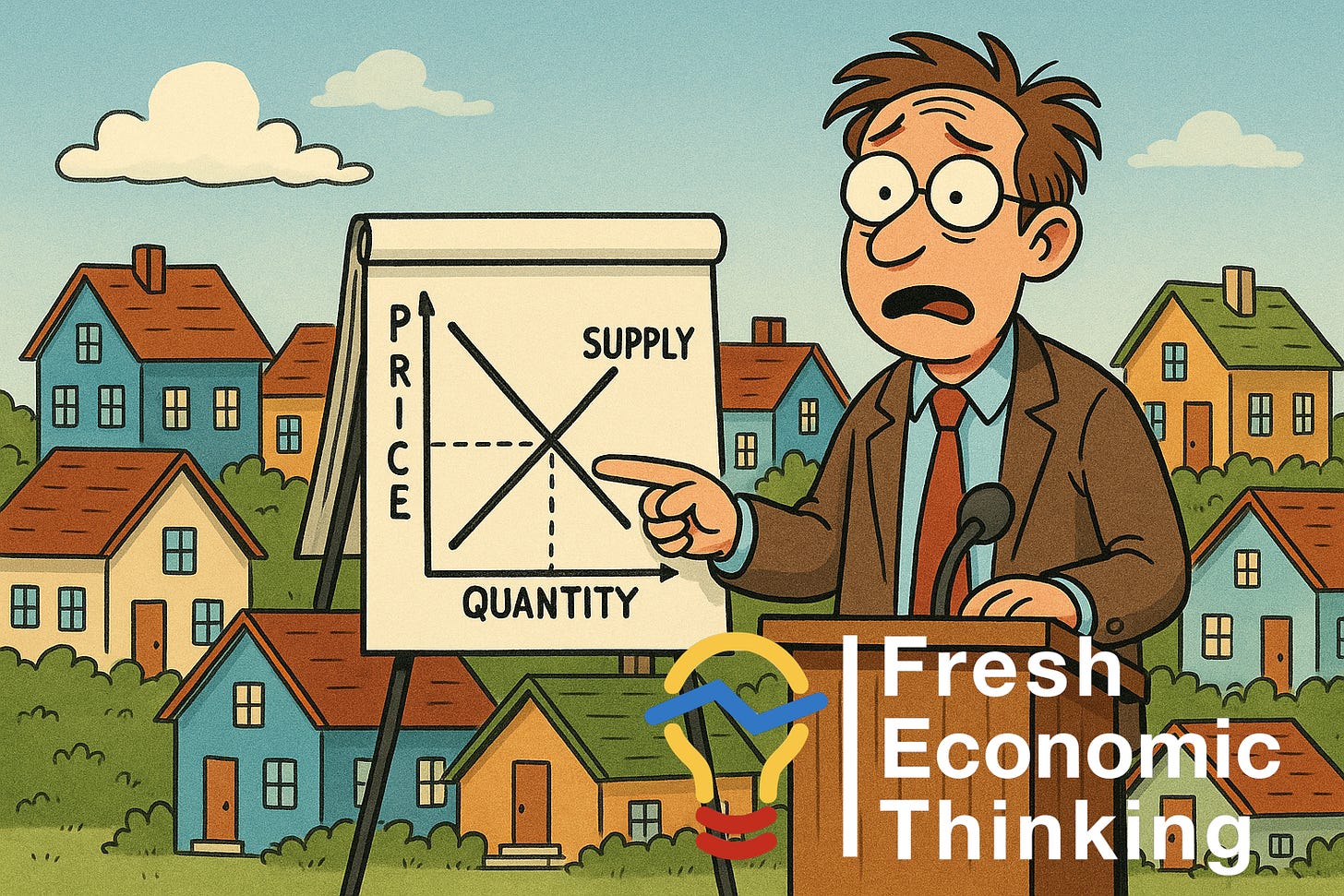Supply and Demand: They MUST apply to housing (Part I)
Those who say supply and demand don't apply to housing are wrong. Yet most of those who swear that their version of supply and demand explains home prices are wrong too.
A part of this Supply and Demand Series will be released each month. Here is a taste of what is to come.
Part I: They MUST apply to housing
Part II: The MANY DIMENSIONS of housing
Part III: The NESTED NATURE of trade
If you would like to follow this series, consider upgrading to a paid subscription and supporting Fresh Economic Thinking.
Supply and demand apply to housing.
There.
I said it.
Is everyone happy?
I doubt it.
I doubt it because supply and demand are loaded terms, filled with our hidden assumptions about what markets should do.
In this article, I will explain that of course supply and demand apply to housing. By definition. But I will add the necessary context and theoretical underpinnings to ensure you don’t assume that supply and demand apply in some ad hoc way.
By the end of this article series, you will appreciate that supply and demand must apply across all possible trading dimensions. You will also be able to identify when supply and demand analysis goes astray by ignoring or confusing the relevant trading dimensions and benefits that apply to the question at hand.
Ready?
A hijacked housing debate
The public debate about which policies might reduce housing rents and asset prices is polarised.
On one side are those who observe that building more homes is never associated with falling prices. For them, supply and demand are not principles of economic exchange but rather a myth.
The other side contains firm believers in economic principles. Debates that should be about how supply and demand apply to housing become hijacked and veer off course into debates about whether to accept or reject economic principles in general.
To be clear, scepticism about most attempts at supply and demand analysis of housing is valid. Popular supply and demand stories about housing usually involve a misapplication of these concepts.
As I explained with Tim Helm in the below paper, reality doesn’t comport with the popular misapplied supply and demand story.
One reason is that when it comes to housing, people don’t experience the type of unexpected supply shocks common in other markets. After a good growing season, for example, people see fruit and vegetable prices fall. But housing production is not subject to such random fluctuations.
Developers do not build more than planned, and only occasionally are they left with unexpected excess stock to clear.
Another reason is that homebuilding is not a short-run production decision. It is an investment decision that responds positively to rising prices. So in the ordinary course of events, rising demand and prices trigger new construction: higher prices and higher quantities are seen going hand in hand.
You can download that full article below.
This hijacked debate hinders our collective understanding of housing markets. We need to stop arguing about whether economic principles apply and start understanding how they apply.
This is why I am writing this Supply and Demand Series.
Supply and demand describe equilibrium
The concepts of supply and demand are tools to help describe the underlying economic concept of equilibrium.
If people can voluntarily trade, then trades will occur until no one can find a trading partner and agree to a trade that makes them both better off. If two people can be better off from trading, they will trade (or, in the lingo, there is an arbitrage opportunity).
The imaginary point that trading pushes towards is an economic equilibrium.
Equilibrium is an emergent property of markets, not a property of an individual exchange. A person can’t be in equilibrium. Nor are exchanges made at the equilibrium—trades are how markets push market outcomes towards equilibrium.
A market equilibrium is also not fixed over time. Remember, it is simply an emergent property of the fact that trades occur when they are beneficial to both buyers and sellers. The forces of selling and buying always apply and always balance, even when prices are changing.
Ocean tides are a useful analogy.
Tides are always rising and falling to sustain a physical equilibrium that balances the gravitational forces of the Earth and Moon (think supply and demand, sellers and buyers). Tidal water movement is analogous to the quantity of trades that balance out the opposing gravitational forces (supply and demand), resulting in an ocean level (price) that changes over time.
Another useful analogy is share (stock) trading.
The equilibrium is the price at which no further trading occurs. But when the force of buying or selling changes, trading happens to move the price, constantly balancing the forces of supply and demand (sellers and buyers).
This might sound obvious to you. Or it might sound a little strange.
The important thing to remember for now is that we often go wrong in our analysis of equilibrium by enforcing many hidden assumptions about what forces are at play (the benefits from trade) and the dimensions across which trade can take place.
Let’s dig in to see this process in action with an analogy and some key insights about supply and demand that will be useful later in this Supply and Demand Series.
Keep reading with a 7-day free trial
Subscribe to Fresh Economic Thinking to keep reading this post and get 7 days of free access to the full post archives.



